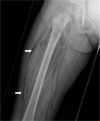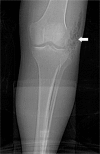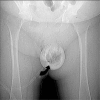Necrotizing fasciitis of the lower extremity: imaging pearls and pitfalls
- PMID: 29537292
- PMCID: PMC6209465
- DOI: 10.1259/bjr.20180093
Necrotizing fasciitis of the lower extremity: imaging pearls and pitfalls
Abstract
Objective: The purpose of this article is to review the imaging findings of necrotizing fasciitis as seen on radiograph, ultrasound, CT, and MRI, and to recognize the early findings in this potentially fatal disease.
Conclusion: Although classically a clinical diagnosis, imaging is a powerful adjunct to facilitate early diagnosis in equivocal cases. Compared to plain radiography, ultrasound, CT and MR provide higher sensitivity and specificity for the diagnosis of necrotizing fasciitis. Cross-sectional imaging findings include asymmetric thickening of fascia, soft tissue air, blurring of fascial planes, inflammatory fat stranding, reactive lymphadenopathy, and nonenhancement of muscular fascia.
Figures










References
Publication types
MeSH terms
LinkOut - more resources
Full Text Sources
Other Literature Sources

